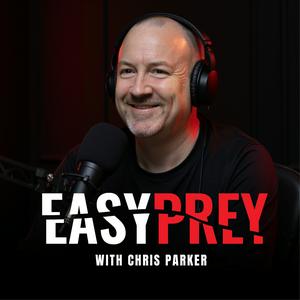Episódios Disponíveis
5 de 301
- Anyone Could Walk InSometimes we forget how much trust we place in the little things around us like a lock on a door or a badge on someone's shirt. We see those symbols and assume everything behind them is safe, but it doesn't always work that way. A person with enough confidence, or the right story, can slip through places we think are locked down tight, and most of us never notice it's happening. My guest today is Deviant Ollam, and he's one of the rare people who gets invited to break into buildings on purpose. He talks about how he fell into this unusual line of work, the odd moments that shaped his career, and why understanding human behavior matters just as much as understanding locks or alarms. Listening to him describe these situations, where he's walking through offices, popping doors, or blending in with repair crews, makes you realize how blind we can be to our own surroundings. We also get into the practical side of things: the mistakes companies make, the small fixes that go a long way, and why teaching employees to slow down and ask a few extra questions can make all the difference. It's an eye-opening conversation, especially if you've ever assumed your workplace is more secure than it really is. Show Notes: [03:24] Deviant shares how early adventures, abandoned buildings, and curiosity about locks pulled him toward physical security. [06:20] A story about a law firm reveals how an office "secure" door was bypassed instantly, exposing major hardware flaws. [09:16] Discussion shifts to how the locksmith and safe technician community reacted to his public teaching and how that's changed over time. [13:28] The topic turns to security theater and the gap between feeling safe and actually being protected. [16:18] An explanation of symbolic locks versus real security products highlights how easily people mix up the two. [19:11] Conversation moves into the lack of clear U.S. lock standards and why European systems make things easier for consumers. [21:51] Layered security comes into focus, emphasizing that the goal is to delay and deter rather than stop every possible attack. [24:35] Monitoring tools, overlooked windows, and forgotten blind spots show how attackers often choose the easiest entry point. [27:38] We look at the politics of penetration tests and why coordinating with building management is essential. [31:28] Escalation testing illustrates how long suspicious behavior can go unnoticed inside an organization. [34:34] The need for simple, obvious reporting channels becomes clear when employees aren't sure who to alert. [37:00] A breakdown of common cover stories shows why attackers lean on confidence and industry jargon. [39:50] Urgency and pressure tactics surface as key components of social engineering and why "polite paranoia" helps. [41:14] A viral prank underscores how easily an unverified person can be escorted into restricted areas. Thanks for joining us on Easy Prey. Be sure to subscribe to our podcast on iTunes and leave a nice review. Links and Resources: Podcast Web Page Facebook Page whatismyipaddress.com Easy Prey on Instagram Easy Prey on Twitter Easy Prey on LinkedIn Easy Prey on YouTube Easy Prey on Pinterest Deviant Ollam Deviant Ollam - You Tube Deviant Ollam - Instagram Practical Lock Picking: A Physical Penetration Tester's Training Guide--------43:26
- The Scam You Never See ComingFraud today doesn't feel anything like it used to. It's not just about somebody skimming a credit card at a gas pump or stealing a check out of the mail. It has gotten personal, messy, emotional. Scammers are building relationships, earning trust, and studying the little details of our lives so they can strike when we're tired, distracted, or dealing with something big. And honestly, most people have no idea how far it's gone. My guest, Ian Mitchell, has spent more than 25 years fighting fraud around the world and leading teams in the financial sector. He's the founder of The Knoble, a nonprofit bringing banks and industry leaders together to protect vulnerable people from scams, human trafficking, and exploitation. Ian has seen the evolution of fraud firsthand, from the old-school days of stolen cards to the organized global crime networks using technology, AI, and human manipulation to scale at a pace we've never experienced before. What stood out to me is Ian's belief that the strongest defense doesn't start with fancy tools or tighter security. It starts at home. Real conversations with our kids about safety online. Checking in on aging parents. Talking openly with people we trust so scammers can't isolate us and break us down. It's serious work, but Ian is hopeful. He believes there are far more good people than bad, and when we look out for each other, we're a lot harder to exploit. Show Notes: [00:58] Ian unexpectedly shifted from music and modeling into the world of fraud prevention. [01:19] Founding The Knoble and building a global network to fight human crimes and protect vulnerable populations. [01:49] A look at Follow the Money, the documentary project raising awareness about exploitation and financial crime. [02:19] Why Ian believes crimes of exploitation have moved directly into our homes and daily lives. [03:08] The early moment when Ian uncovered a major fraud ring while working at an internet company. [06:44] How canceling $300,000 in fraudulent orders changed the direction of his career. [08:11] Reflections on the "wild west" early days of online fraud and security. [11:01] How fraud evolved from stolen cards into emotional manipulation and trust-based scams. [12:49] The post-COVID surge in scams and the shift toward targeting individuals instead of systems. [14:03] Why fighting fraud today requires global coordination and an army of trained professionals. [16:38] Scammers coaching victims to distrust banks, friends, and even family members. [17:05] The longest romance-style scam Ian has seen — an eight-year manipulation before money was ever requested. [18:25] Discussion on timing, trust, and why even smart people can be caught off guard. [22:05] Ian shares his own experience dealing with identity theft and the complexity of proving it wasn't him. [23:22] AI and big data transforming broad scam attempts into precise, personalized attacks. [25:31] The alarming rise of sextortion schemes targeting kids ages 13–16 and why awareness is critical. [26:40] The urgent need for uncomfortable safety conversations within families. [28:09] Why Ian believes the first line of defense isn't technology — it's communication at home. [29:30] The emotional impact on scam victims: shame, isolation, and loss of confidence in judgment. [31:13] How AI can be used for good and why the industry must move quickly to fight back. [40:40] Three essential conversations families should start having right now. [41:21] Protecting children through parental controls, boundaries, and digital safety. [42:42] Encouraging open dialogue with aging parents about financial protection and autonomy. [44:19] Finding balance: staying vigilant without living in fear. [47:57] A hopeful reminder that there are far more good people than bad — and collective action matters. [48:30] Where to find Ian, learn more about The Knoble, and connect with his work. Thanks for joining us on Easy Prey. Be sure to subscribe to our podcast on iTunes and leave a nice review. Links and Resources: Podcast Web Page Facebook Page whatismyipaddress.com Easy Prey on Instagram Easy Prey on Twitter Easy Prey on LinkedIn Easy Prey on YouTube Easy Prey on Pinterest The Knoble Ian Mitchell - LinkedIn--------49:25
- Hacking AIAI has brought incredible new capabilities into everyday technology, but it's also creating security challenges that most people haven't fully wrapped their heads around yet. As these systems become more capable and more deeply connected to the tools and data we rely on, the risks become harder to predict and much more complicated to manage. My guest today is Rich Smith, who leads offensive research at MindGard and has spent more than twenty years working on the front lines of cybersecurity. Rich has held leadership roles at organizations like Crash Override, Gemini, Duo Security, Cisco, and Etsy, and he's spent most of his career trying to understand how real attackers think and where systems break under pressure. We talk about how AI is changing the way attacks happen, why the old methods of testing security don't translate well anymore, and what happens when models behave in ways no one expected. Rich also explains why psychology now plays a surprising role in hacking AI systems, where companies are accidentally creating new openings for exploitation, and what everyday users should keep in mind when trusting AI with personal information. It's a fascinating look behind the curtain at what's really going on in AI security right now. Show Notes: [01:00] Rich describes getting into hacking as a kid and bypassing his brother's disk password. [03:38] He talks about discovering Linux and teaching himself through early online systems. [05:07] Rich explains how offensive security became his career and passion. [08:00] Discussion of curiosity, challenge, and the appeal of breaking systems others built. [09:45] Rich shares surprising real-world vulnerabilities found in large organizations. [11:20] Story about discovering a major security flaw in a banking platform. [12:50] Example of a bot attack against an online game that used his own open-source tool. [16:26] Common security gaps caused by debugging code and staging environments. [17:43] Rich explains how AI has fundamentally changed offensive cybersecurity. [19:30] Why binary vulnerability testing no longer applies to generative AI. [21:00] The role of statistics and repeated prompts in evaluating AI risk and failure. [23:45] Base64 encoding used to bypass filters and trick models. [27:07] Differentiating between model safety and full system security. [30:41] Risks created when AI models are connected to external tools and infrastructure. [32:55] The difficulty of securing Python execution environments used by AI systems. [35:56] How social engineering and psychology are becoming new attack surfaces. [38:00] Building psychological profiles of models to manipulate behavior. [42:14] Ethical considerations and moral questions around AI exploitation. [44:05] Rich discusses consumer fears and hype around AI's future. [45:54] Advice on privacy and cautious adoption of emerging technology. Thanks for joining us on Easy Prey. Be sure to subscribe to our podcast on iTunes and leave a nice review. Links and Resources: Podcast Web Page Facebook Page whatismyipaddress.com Easy Prey on Instagram Easy Prey on Twitter Easy Prey on LinkedIn Easy Prey on YouTube Easy Prey on Pinterest Mindgard [email protected]--------47:40
- The Ransomware WarRansomware isn't a lone hacker in a hoodie. It's an entire criminal industry complete with developers, brokers, and money launderers working together like a dark tech startup. And while these groups constantly evolve, so do the tools and partnerships aimed at stopping them before they strike. My guest today is Cynthia Kaiser, former Deputy Assistant Director of the FBI's Cyber Division and now the Head of the Ransomware Research Center at Halcyon. After two decades investigating global cyber threats and briefing top government leaders, she's now focused on prevention and building collaborations across government and industry to disrupt ransomware actors at their source. We talk about how ransomware groups operate, why paying a ransom rarely solves the problem, and what layered defense really means for organizations and individuals. Cynthia also shares how AI is reshaping both sides of the cyber arms race and why she believes hope, not fear, is the most powerful tool for defenders. Show Notes: [01:04] Cynthia Kaiser had a 20-year FBI career and has now transitioned from investigation to prevention at Halcyon. [03:58] The true scale of cyber threats is far larger than most people realize, even within the government. [04:19] Nation-state and criminal activity now overlap, making attribution increasingly difficult. [06:45] Cynthia outlines how ransomware spreads through phishing, credential theft, and unpatched systems. [08:08] Ransomware is an ecosystem of specialists including developers, access brokers, money launderers, and infrastructure providers. [09:55] Discussion of how many ransomware groups exist and the estimated cost of attacks worldwide. [11:37] Ransom payments dropped in 2023, but total business recovery costs remain enormous. [12:24] Paying a ransom can mark a company as an easy target and doesn't guarantee full decryption. [13:11] Example of a decryptor that failed completely and how Halcyon helped a victim recover. [14:35] The so-called "criminal code of ethics" among ransomware gangs has largely disappeared. [16:48] Hospitals continue to be targeted despite claims of moral restraint among attackers. [18:44] Prevention basics still matter including strong passwords, multi-factor authentication, and timely patching. [19:18] Cynthia explains the value of layered defense and incident-response practice drills. [21:22] Even individuals need cyber hygiene like unique passwords, MFA, and updated antivirus protection. [23:32] Deepfakes are becoming a major threat vector, blurring trust in voice and video communications. [25:17] Always verify using a separate communication channel when asked to send money or change payment info. [27:40] Real-world example: credential-stuffing attack against MLB highlights the need for two-factor authentication. [29:55] What to do once ransomware hits includes containment, external counsel, and calling trusted law-enforcement contacts. [32:44] Cynthia recounts being impersonated online and how she responded to protect others from fraud. [34:28] Many victims feel ashamed to report cybercrime, especially among older adults. [36:45] Scams often succeed because they align with real-life timing or emotional triggers. [38:32] Children and everyday users are also at risk from deceptive links and push-fatigue attacks. [39:26] Overview of Halcyon's Ransomware Research Center and its educational, collaborative goals. [42:15] The importance of public-private partnerships in defending hospitals and critical infrastructure. [43:38] How AI-driven behavioral detection gives defenders a new advantage. [44:48] Cynthia shares optimism that technology can reduce ransomware's impact. [45:43] Closing advice includes practicing backups, building layered defenses, and staying hopeful. Thanks for joining us on Easy Prey. Be sure to subscribe to our podcast on iTunes and leave a nice review. Links and Resources: Podcast Web Page Facebook Page whatismyipaddress.com Easy Prey on Instagram Easy Prey on Twitter Easy Prey on LinkedIn Easy Prey on YouTube Easy Prey on Pinterest Halcyon Cynthia Kaiser - LinkedIn--------47:20
- Opportunistic CrimesCriminals are always adapting. Whether it's copper wiring stripped from job sites or porch pirates grabbing deliveries in broad daylight, they keep finding new ways to take what isn't theirs. But maybe prevention isn't about harsher punishment or more cameras. Maybe it's about smarter design and understanding what drives people to steal in the first place. My guest today is Dr. Ben Stickle, a professor of criminal justice at Middle Tennessee State University and one of the country's top researchers on property crime. Before entering academia, he worked in law enforcement, which gives him a rare mix of real-world perspective and research-based insight. His work on metal theft, catalytic converter crime, and package theft sheds light on who's actually committing these offenses, what motivates them, and which prevention methods truly work. We discuss how fluctuating metal prices influence theft rates, why cameras often fail to stop certain crimes, and how a few simple design changes to your home can make a real difference. Dr. Stickle also shares unexpected examples of modern theft, from stolen pets to disappearing beehives, and explains how communities can act early before small trends turn into national headlines. Show Notes: [01:22] Ben recalls his early years as a police officer and what motivated him to serve. [01:27] The conversation moves into crime scene investigation training and lessons from real-world cases. [03:38] Ben talks about transitioning into teaching and research, guided by a drive to improve policing through knowledge. [05:30] The focus turns to crime prevention and understanding how to stop crimes before they happen. [06:15] Discussion shifts to metal theft, from copper wiring to catalytic converters, and the steep cost of replacing what's stolen. [10:47] Ben explains how metal theft isn't new, tracing its roots all the way back to ancient Greece. [14:58] The challenges of balancing better security design with cost and practicality come to light. [17:46] The topic turns to porch piracy and why package theft has become one of the most common crimes in America. [19:43] Ben breaks down how daily routines influence theft risk and how thieves range from organized groups to impulsive opportunists. [25:23] The role of cameras is questioned as Ben explains why surveillance doesn't always deter crime. [27:00] Practical prevention strategies emerge like delivering to lockers, hiding packages, and using better drop-off options. [28:53] New tech enters the discussion with alarms, GPS tracking, and geofencing tools designed to stop porch pirates. [29:14] Ben explores how rethinking porch layouts could help protect deliveries and reduce crime opportunities. [31:47] The conversation expands to environmental criminology and how physical spaces can influence criminal behavior. [34:00] Ben emphasizes the importance of targeted prevention instead of one-size-fits-all solutions. [38:00] The value of using local crime data, rather than fear-driven news, to make safety decisions is underscored. [40:30] Emerging trends come up, from pet and beehive thefts to crimes tied to the growing sharing economy. [42:00] The episode wraps with takeaways on prevention, awareness, and where listeners can find Ben's research. Thanks for joining us on Easy Prey. Be sure to subscribe to our podcast on iTunes and leave a nice review. Links and Resources: Podcast Web Page Facebook Page whatismyipaddress.com Easy Prey on Instagram Easy Prey on Twitter Easy Prey on LinkedIn Easy Prey on YouTube Easy Prey on Pinterest The Knoble Freddy Massimi - LinkedIn--------42:40
Mais podcasts de Notícias
Podcasts em tendência em Notícias
Sobre Easy Prey
Chris Parker, the founder of WhatIsMyIPAddress.com, interviews guests and tells real-life stories about topics to open your eyes to the danger and traps lurking in the real world, ranging from online scams and frauds to everyday situations where people are trying to take advantage of you—for their gain and your loss.
Our goal is to educate and equip you, so you learn how to spot the warning signs of trouble, take quick action, and lower the risk of becoming a victim.
Site de podcastOuça Easy Prey, Petit Journal e muitos outros podcasts de todo o mundo com o aplicativo o radio.net

Obtenha o aplicativo gratuito radio.net
- Guardar rádios e podcasts favoritos
- Transmissão via Wi-Fi ou Bluetooth
- Carplay & Android Audo compatìvel
- E ainda mais funções
Obtenha o aplicativo gratuito radio.net
- Guardar rádios e podcasts favoritos
- Transmissão via Wi-Fi ou Bluetooth
- Carplay & Android Audo compatìvel
- E ainda mais funções


Easy Prey
Leia o código,
baixe o aplicativo,
ouça.
baixe o aplicativo,
ouça.






































